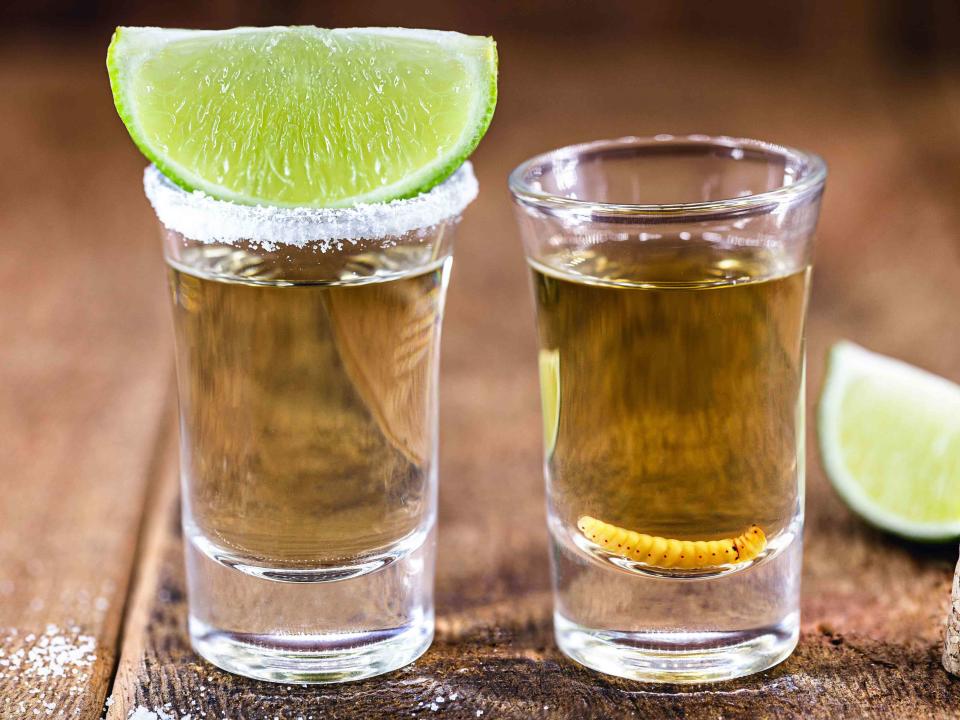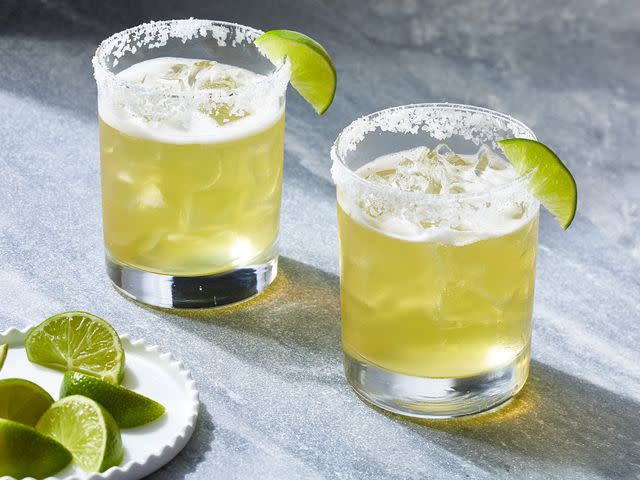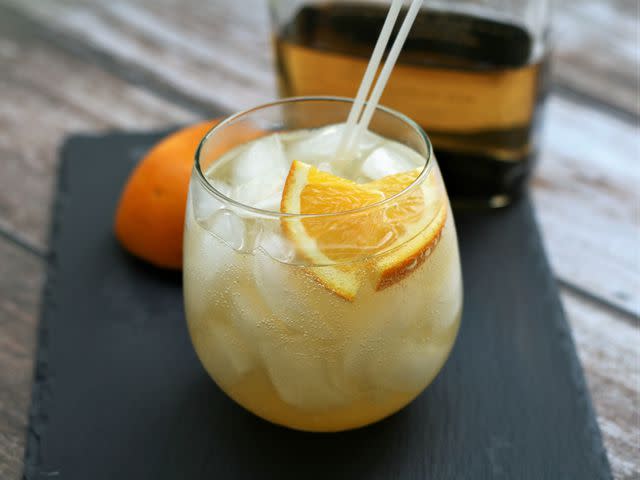Mezcal vs. Tequila: What's the Difference?
Here's what you need to know.

RHJ/Getty Images
For a long time, if it was an agave-based drink you were after at a bar or restaurant, the only option on the menu was tequila (and who doesn’t love a good margarita?). Nowadays, not only have the options for tequila expanded dramatically, but you’ll see a number of choices for mezcal, whether you’re familiar with what it is or not.
There’s a handy phrase thrown about that you may have heard: All tequila is mezcal, but not all mezcal is tequila. And while that’s all well and good and even useful to keep in mind once you’re familiar with both, until then it might as well be gibberish.
So let’s dive into these two spirits and find out what makes them simultaneously so similar and so unique.
Mezcal vs. Tequila
Mezcal and tequila are both distilled spirits with a deep Mexican history that come from the agave plant, so it’s no wonder they’re easily confused.
Any agave spirit is a mezcal, as the word mezcal quite literally refers to spirits made from the agave plant. A good way to think about this is in the same way that bourbon is a kind of whiskey, pinot noir is a type of wine, and tequila is a portion of mezcal.
Though tequila may seem like the original, with mezcal’s prevalence and popularity making it a relatively new addition to liquor-slinging establishments all over, mezcal is the OG, dating back thousands of years. Tequila has simply had the benefit of being a major commercial product, whereas mezcal is still a small operation by comparison, often artisanal.
One of the largest differences is that mezcal can be made from any type of agave, whereas tequila must use blue Weber agave and only blue Weber agave. On top of that, it can only come from five states in Mexico. But one of the largest similarities is their success in cocktails, lending complexity and excitement to quite a range of drinks.

Dotdash Meredith Food Studios
What Is Mezcal?
With the spirit being more widely available than ever before, bartenders are harnessing the nuances of the spirit in their concoctions, yielding delicious results. But mezcal is traditionally served neat. (Do you like to drink scotch? Are you particularly partial to peated scotch? Try mezcal neat. Thank us later.)
The largest distinction between mezcal and tequila in terms of flavor is the signature smokiness mezcal has. But that smoke can be anything from a whisper to a bombardment, depending on the brand, and that difference is part of what makes mixing with it fun and exciting. Different mezcals will do different things in drinks. Regardless, mezcal is a bold spirit—there's no doubt about it—and it likes to assert itself. Other tasting notes to note are bold tones of earth and citrus, with some expressions boasting tropical flavors and some reading bitter.
Related: 8 Deliciously Smoky Mezcal Cocktails
Agave for Mezcal
As previously mentioned, mezcal is unique in that it can be made from any type of agave. In fact, it might come from any one of 30 types of agave plants. The spirit is most often made in Oaxaca, a southwestern Mexican state, but it also hails from Michoacan, San Luis, Zacatecas, Guerrero, and Chihuahua. Similar to wine, where it is made will dictate a different and distinct terroir profile.
This spirit is important to Mexican culture and varies greatly from town to town in its flavor, cementing its status as an incredibly individual spirit.
Angustifolia is the most common agave plant used for mezcal, and it takes 6–8 years to mature. This agave may also be called Espadín, Espadilla, pelón verde, or tepemete. (Not confusing at all, right??) This particular plan has a high concentration of sugars and creates a mezcal that tastes herbaceous and fruity at the same time.
Marmorata (also called Pichumel or Tepeztate) agave is also a popular choice for mezcal, but it takes 35 years to come to maturity. This means that if the mezcal you’re sipping is made from it, it’s probably pretty expensive. It’s also a spicier and more intense spirit.
The small plant potatorum (also called Papolome or Tobalá) is known for being sweet and is another version that will come with a risk of sticker shock.

Types Of Mezcal
It’s harder to get the hang of the types of mezcal than it is with tequila. For tequila, it’s pretty cut and dry, but for mezcal, both the age and the type of agave plant used in its production are taken into account to classify it. There are also some differences in the methods of distillation that might classify it differently. Producers are more likely to focus on the type of agave plant used than the aging of it, since the plant will affect the taste more than the aging.
Joven or Blanco: unaged and no color
Madurado en Vidrio: means “matured in glass," so (unsurprisingly) it is aged in glass for at least one year. This will happen in a light-free, temperature-controlled place, or simply underground.
Reposado: aged in any type of wood for 2–12 months.
Anejo: aged in any type of wood for a minimum of one year.
What Is Tequila?
Where mezcal enjoys near-infinite freedom, tequila is tightly controlled. The Mexican government will only allow blue weber agave to be used for the production of tequila. The spirit must also only be produced in the state of Jalisco, with very few exceptions, and the process of making it is much more standardized.
Tequila is easily produced on a large scale, which is why it has (until fairly recently, anyway) been more common in the bar scene. That easy procurement, combined with its wide range of flavor profiles, makes for some tasty cocktails. Tequila can taste like earth or fruit, have vegetal notes or nods toward herbs or citrus, or even have a subtle smoke to it. Grass and yams are common qualifiers to the taste, and when aged, tequila can take on dessert-y qualities like vanilla, cinnamon, or even caramel, which is why the aged varieties are more likely to be enjoyed neat.
Agave for Tequila
Though blue Weber agave is the only agave allowed in tequila, there are still two types of the spirit: pure and mixto. Pure tequila is made from 100 percent agave, and mixto is a combination of pure agave and sugars from other sources. Needless to say, it’s best to avoid mixto. When in doubt, check the label; if it doesn’t boast 100 percent, you’re looking at a mystery blend of fermented sugar plus some other additives, including artificial coloring.
Related: Our 16 Best Tequila Cocktails
Types Of Tequila
Tequila ranges from unaged to heavily aged. Like other spirits, the longer it sits, the darker it gets and the more the flavor changes.
Blanco: AKA clear, sometimes called silver or white. This tequila is aged for less than two months (if it is at all), likely in stainless steel but possibly in oak tanks. Blanco tequila is required to be bottled within 60 days. Known as "light, bright, and juicy," this variety is very fresh, the most vegetal, and a bit spicy from a lack of age to mellow it. Something good to remember is that when a spirit is left unaged, it expresses itself naturally, fully tasting the ingredients. (Aging allows it to take on additional flavors brought on by the container it’s aged in.)
Joven: also called gold, this tequila is a blend of white and aged or blanco plus additives (we’d pass, but you do you).
Reposado: A rested tequila, creating a more complex flavor profile with rounded edges. The minimum aging time is two months, and it must take place in oak casks. Its deeper body makes it incredibly desirable to drink straight or add to a cocktail.
Anejo: Its noticeably dark color comes from a minimum aging of one year in oak. Rich, nuanced, and lovely, this tequila is the most likely to be enjoyed neat and the most enticing for whiskey drinkers.
Extra Anejo: The oldest and the darkest. Extra Anejo must be aged for a minimum of three years in oak and is known for its notes of intense vanilla and baking spices.

France C
How Are Mezcal and Tequila Made?
Both mezcal and tequila are made from the piña, or the heart, of the agave plant, which is reached once the spiky leaves are cut off. That piña is then cooked and crushed, and the juice pulled out is fermented and distilled. How the piña is cooked differentiates tequila and mezcal.
Mezcal, being one of the oldest and most historical spirits in Mexico, begins unsurprisingly by cooking the piña in a very traditional method (usually involving an underground stone pit with charcoal) and being covered for several days. That roasted heart is then crushed and allowed to ferment, causing the characteristic smokiness the spirit proudly boasts.
This old and historic process of creating mezcal explains the small-batch nature of the spirit.
Mezcal is very transparent in its labeling, communicating everything down to the village where it was made, the area where the agave was grown, how the agave was roasted, and in what still. The makers of mezcal are rightfully proud, whereas tequila producers can get a little hush-hush about everything.
The piña for tequila can be cooked in many ways, but the best quality stuff is done in a brick oven. Other types might use a steam heat and pressure system to cook more quickly, while some producers opt for a chemical method of stripping the juice out of the agave. (As you can imagine, this does not produce the most ideal-tasting product.) That said, maybe don’t go for the most inexpensive bottle on the shelf. You don’t have to break the bank, but something a bit pricier than the lowest tier will serve your tastebuds well.
Read the original article on All Recipes.

